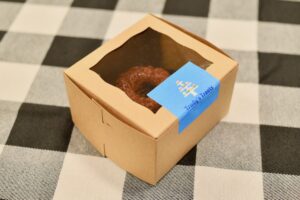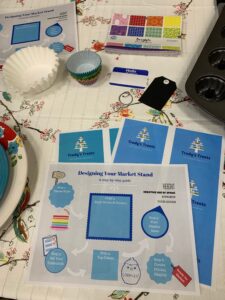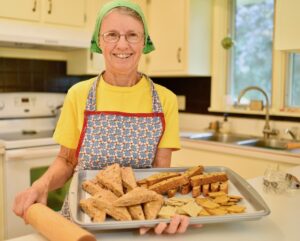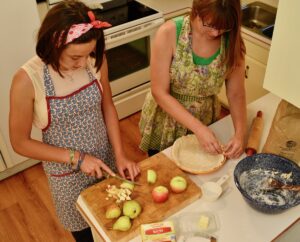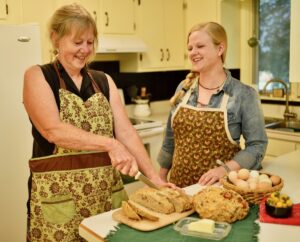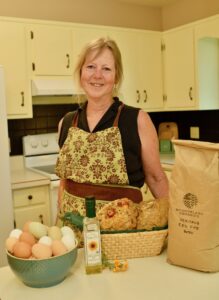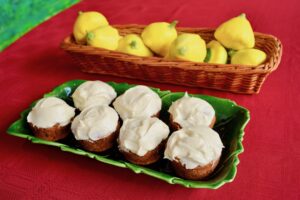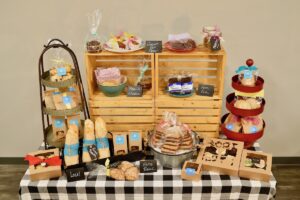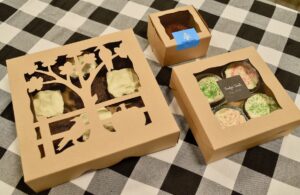Final report for FNC18-1130
Project Information
Our farmer team consists of five women farmers all running small-scale, diversified operations practicing sustainable agriculture.
Lisa Kivirist (20+ years): Inn Serendipity Farm and B&B: Vegetables, renewable energy, agritourism
Linda Derrickson (20+ years): Bluffwood Landing: Vegetables, sheep/fiber
Ashley Wegmueller (approx. 5 years): Bo & Olly Produce: Vegetables, agritourism
Dela Ends (20+ years): Scotch Hill Farm and Innisfree Farmstay: Vegetables, agritourism
Kalena Riemer: Riemer Family Farm: Pastured Meats (Kalena is the 13-year-old daughter of the Riemers who run Riemer Family Farm)
The original farmer team submitted on the grant application was just three women: Kivirist, Wegmueller and Derrickson. Ends and Riemer really stepped up to the project plate and contributed so much we wanted to officially expand our team.
1. Problem addressed and the solution pursued:
Problem:
The good news is that almost every state now has a bakery cottage food law, legislation that allows non-hazardous baked goods to be produced in a home kitchen for direct-to-consumer sale. However, while cottage food offers opportunity for farmers to diversify into value-added products; no resources exist to support farmers in producing baked goods that look professional and utilize ingredients grown on the farm. It’s easy to bring chocolate chip cookies to market, but that product doesn’t add value to what we farmers are growing.
Additionally, as farmers bring small batches to market, the packaging and product display tends to look more like a “bake sale” with baggies and plastic wrap rather than something one would expect from a real bakery.
Solution:
This project created a toolkit of recipes and resources for farmers to create baked goods in their home kitchen that utilize farm raised ingredients and are displayed in a professional manner, resulting in diversified sales leading to economic vitality. By using produce in baked goods, particularly blemished product, we keep more land in sustainable, ecologically sound production. Additionally, as cottage food products are sold directly to customers, such transactions enhance farmer quality of life by building healthy community connections.
2. The project's research approach, educational approach and farmer learning outcomes:
Research approach:
Our team took a collaborative, "divide and conquer" approach to this project with each of us taking a different section based on our background, expertise and interest:
Lisa Kivirist: Project coordinator; lead recipe tester
Ashley Wegmueller: Market design development and packaging development
Linda Dee Derrickson: Recipe development (crackers)
Dela Ends: Recipe development (breads & Rolls)
Kalena Riemer: Recipe development (cookies)
Danielle Matson: Recipe development (frostings, muffins) & recipe testing support
Note that for the recipe development and testing side, this project took us all into the area of food science way deeper than any of us had experience in. We really appreciate this opportunity via this Farmer Rancher grant to dig into all of this and have the space and time to develop the recipes.
We were fortunate to develop an ally in our local community college: Blackhawk Technical College in Monroe, WI. The college both allowed us to use their chemistry lab to conduct initial water activity level tests as well as provide food science expertise to answer our many questions and provide guidance. The fact that we could use their lab played a huge role in managing our project budget as we had to test many of the recipes multiple times before achieving the .85 or below water activity level. Only then did we send them to the official, certified lab (Diebel Labs in Madison, WI) for the final test, which increased in price from our original grant estimate from $25 to $35 a test.
Educational approach:
Our educational approach throughout this project was very collaborative, both within our farmer team and connecting with others. Each workshop, focus group and outreach event we did (See “Educational and Outreach Activities”) gave us an opportunity to ask questions, gain feedback and gather insight from the questions farmers were asking to create and refine our materials.The key educational element for this project is the main website: www.cottagefoodhomebakery.com. In the original grant, we had proposed to design and print a traditional paper toolkit, but realized that we simply had too much (good!) content for this to be financially feasible or usable in that form. Additionally, with our team’s commitment to sustainability, a website made much more strategic sense than loads of paper products and gave us opportunity to have a much wider project reach.
A key element of the website is an interactive database where you can search for recipes by ingredient. All recipes can be readily printed via a pdf option and the produce and vegetable recipes include the official water activity test results from Diebel Lab. As states already allow breads under their cottage food law as non-hazardous items, tests were not needed for the breads.
The website also contains information and ideas on packaging and creating an attractive farmer's market display. The website format enabled us to use a lot more color photos than we ever could have in a printed format. We also added a project overview webinar.
Farmer learning outcomes:
Key learnings among our farmer team:
• We all developed an appreciation for the food science side of producing value-added products. We learned a lot about how water activity works and how ingredients interact.
• Innovation is key! We started thinking this project would just include recipes but then came up with the idea of add-on sales like offering croutons if you sell salad greens. We also evolved the "toolkit" concept from a paper printed item to a website, which turned out to be a much stronger format.
• Collaboration is key! While it took effort to schedule in-person meetings with all of our busy farm schedules, when we all got together and shared collaboratively, that's what really fueled the creative juice behind this project.
3. Succinct statement of research conclusions
Key conclusions via the recipe research & development:
• Recipes involving high water content vegetables or fruits are challenging to develop that meet the .85 required non-hazardous water activity level. We spent much more time than we initially planned on testing recipes as most initially came back too high in water activity level.
• Through experimentation, we learned that shredding the item can generally lower the water activity level while also adding to moisture in the end product, which you want. For high-water items like zucchini, both shredding and then sprinkling with salt and letting it sit for an hour drains a lot of the water. We then needed to experiment with the recipe to add back in oil or other ingredients to keep the overall moisture and taste levels up. While increasing sugar often helped lower the water activity level, this proved to be challenging for our team as inherently we wanted to keep the end product lower in sugar and overall healthier.
Key conclusions via the display and packaging research & development:
• There are a great variety of packaging options made with recycled content and/or are compostable. Ashley Wegmueller compiled a very helpful interactive chart listing specific recommended and tested packaging products.
• Small and cute sells. Taking a dozen zucchini muffins to the farmer’s market may seems like a fine idea, but if you add some frosting and package those individually (see photo), it takes on a “present” like feel and would sell at a much higher mark-up and end net profit.
4. Farmer adoption actions that resulted from the educational program
In all of our multiple outreach events, response to this project and the resources created was very positive from farmers. The vast majority of the farmers we connected with had not yet started their value-added home bakery business so these resources were helpful to support them in launching successfully.
This project supports farmers diversifying to include small-batch homemade baked goods sales using their farm-raised product through the following, a goal that we collaboratively met with the final end project. While some elements may have adapted (and expanded!) as noted, we are collectively proud of and pleased with how everything came together.
1. Develop a Resource Toolkit
While we met the original goals outlined below, we created this via a Toolkit via a website versus the original proposed printed guide, www.cottagefoodhomebakery.com. This worked much better and gave us more opportunity to include photos and more information. Our recipes also included various bread that both use herbs and other farm-raised ingredients and that could be add-on sales to other items you are bringing to market (i.e., croutons if you sell salad greens).
As of 3/23/20, our website received over 1,000 hits thus meeting our project outreach goal. We expect this to definitely increase in the months ahead. We also made sure the website has strong SEO with key search words to be readily found.
• 30 non-hazardous recipes using farm produce
• 4 Non-hazardous frosting recipes
• Packaging & display ideas
2. Create & host multiple trainings
Our webinar came out as planned; however, originally, we were planning on doing just two farmer workshops and ended up doing five (see Educational and Outreach Activities). We were able to piggy-back on existing events such as the MOSES Conference which allowed us to do targeted outreach at venues were farmers were already gathering. Thanks to NCR-SARE for additional travel funding to attend the National Women in Sustainable Agriculture Conference as part of the Farmer Forum and present on this project.
• Created a project webinar (for Midwest & national access)
• Hosted five farmer workshops
3. Share findings via outreach
In addition to outreach via various sustainable agriculture organizational networks interested in and supportive of the project, we were able to earn a variety of media helping promote the event (see Educational and Outreach Activities for full media list).
• Outreach via partner groups farmer team is involved with, including MOSES, Renewing the Countryside, Farmers Union, Illinois Stewardship Alliance, Minnesota Farmers Market, etc.
• Garnered strong media interest with multiple articles about this project.
Cooperators
- (Educator and Researcher)
- (Educator)
- (Educator and Researcher)
- (Educator)
- (Educator and Researcher)
- (Educator and Researcher)
- (Educator and Researcher)
Research
Our farmer team researched and tested recipes with one of us also researching packaging. Key process/learnings include:
- Recruit additional expertise
The bulk of our project focused on testing value-added recipes to meet the non-hazardous FDA requirements for cottage food sales out of home kitchens of a water activity level of .85 or less. This was an interesting, new learning journey for our farmer team because while we are all enthusiastic farmers and home bakers, none of us are food scientists nor professional pastry chefs. We quickly realized we needed additional expertise and were fortunate to find a pastry chef (Danielle Matson) in our community who enthusiastically jumped in. As Swiss Colony, a large food manufacturer, is located in our area, we worked with human resources to find someone with a food science background who would be willing to mentor us and to whom we can ask questions. We were very fortunate to connect with Hannah Kramer at Swiss Colony who supports this project and is tutoring us in everything from acidity levels to recipe tweaking.
- Recipe testing
We needed to test over 50 recipes to find the ones included that met the non-hazardous criteria as well as incorporate farm-raised items. Each member of our baking team took a different category from crackers to cookies to breads. While some recipes are clearly non-hazardous from the start, like crackers, recipes that used pumpkin/squash puree and zucchini required a lot more work and time. Hannah Kramer our food scientist expert was very helpful here to make suggestions on tweaking ingredients as needed, like using vegetable oil instead of butter and straining some water off the puree to “dry” it out a bit. That said, we still needed a tasty product at the end. Importantly, we realized we also needed to create recipes that don’t use other non-farm ingredients that are so expensive or so labor-intensive that farmers can’t produce small batches and sell at a profit. "No $20 muffins" was our mantra!
Our original grant submission and project focused exclusively on recipes that met the non-hazardous water activity level of .85 or less. We learned there can be another element to factor into defining something as non-hazardous that also involved testing ph/acidity level of a product. That proved to be needing food science expertise beyond our ability as well as additional costs for more testing. That said, this would be a great area to explore in a future, targeted grant project.
- Tap into community resources
We were able to utilize for free our local Blackhawk Community College to do multiple initial water activity tests on our products before doing the official test at a certified lab that cost money. Additionally, the science teachers at the college were super helpful and knowledgeable in helping us navigate non-hazardous requirements. We didn’t even realize we had such a helpful, free resource right in our own community until halfway through the project. Our learning is to keep asking questions locally; undoubtedly there are terrific experts and mentors right in your own community.
- Focus groups
In addition to many informal focus groups and idea gathering sessions at our area women in sustainable agriculture potlucks, we held a formal focus group in October; Agenda-Oct3-Brainstorming. We gathered a range of people to brainstorm ideas, both farmers but also enthusiastic farmers market shoppers (i.e., what would they buy) and local creative professionals (i.e., the director of the Monroe Arts Center). This worked great to generate new ideas, such as a healthy granola-style “power” bar which ended up being our Sweet Potato Breakfast Cookie recipe.
Additionally, at various other meetings and events our team brought samples and recipe variations for testing and input. This also gives us a “test run” on how perishable something might be. A cracker recipe was tasty, for example, but broke apart during a short car ride and won’t work.
- Crowdsourcing
Throughout this project, we tapped into the super collaborative group of farmers and home bakers supportive of this project for advice and input. This included gathering feedback via online portals like the Wisconsin Cottage Food Facebook page and Wisconsin Home Bakers for recipes and other ideas. We also tapped into local expertise to help proof the recipes and website. Wilton products donated baking pans. We are very grateful for everyone's support and added an acknowledgement section on the website.
• Realistic timelines
The recipe development side took longer than we anticipated, adding in the reality that our farmer team was very busy during the growing season so most of the recipe testing needed to take place during the off-season. We appreciated the extension offered by NCR SARE so that we could successfully complete our project.
Our team, bottom line, met our objectives of the number of recipes and additional resources for this on-line Toolkit. Our project was perhaps unusual as we really didn’t have a conventional baseline or anything really to compare it against as this truly was the first Toolkit and resource created specifically targeting farmers looking to add a value-added product to their business mix.
Throughout the project, we experimented with different locally-raised flours as well as more local, natural sweeteners such as sorghum and molasses. This has been a rewarding opportunity to connect with regional small grain producers and adapt recipes that use more locally-raised grains. For example, we are finding that spelt flour (raised here in Wisconsin) can be used in some cases as a substitute for a commercial, basic white flour.
Educational & Outreach Activities
Estimate 6 new farmers learned about the project/sampled/gave feedback at six events = 36
Participation Summary:
Our team prioritized outreach and building awareness of this project, which exceeded the outreach goals originally set in the grant proposal. Our outreach fell into five key categories: Workshops and In-Person Education/Consults; Online webinar, Media & Articles, Photography and Focus Groups. See below for details.
Note the 209 total unique farmers reached is the workshop total (173) plus 36 farmers engaged via focus groups and other meetings.
A. Workshops & In-Person Education/Consults
Summary: Our team presented at 5 venues, reaching approximately 173 attendees, approximately 18 of which were ag professionals.
- MOSES Conference 2019
Date: 2/22/2019
Location: LaCrosse, Wisconsin
Description: Lisa Kivirist gave a cottage food workshop during which she gave an overview of the project and goals.
Attendance: 55, including 5 agriculture professionals.
2. Two MOSES In Her Boots Workshop
Date: 8/2/19
Location: Riemer Family Farm (Brodhead, WI)
Description: Team members Dela Ends and Lisa Kivirist shared the project along with other diversification resources during a breakout session at this women farmer focused event.
Attendance: 30 women farmers, including 2 agriculture professionals
Date: 8/13/19
Location: Two Pony Gardens/Lady Fern Farm (Long Lake, MN)
Description: Lisa Kivirist shared the project and other diversification resources during the “resource sharing” at lunch
Attendance: 34 women farmers, including 5 agriculture professionals.
3. National Women in Sustainable Agriculture Conference
Date: 10/19/19
Location: St. Paul, MN
Description: Team members Dela Ends, Kalena Riemer and Lisa Kivirist gave a 90 minute presentation: Launch a Bakery from Your Farm Kitchen. This workshop was part of the Farmer Forum track facilitated by NCR SARE. We were grateful for this opportunity via SARE to have travel and registration costs covered to attend and share our project.
Description:
Thanks to increasing cottage food laws across the country, you can add a value-added component to your operation using your home kitchen. Led by the women farmers behind the successful lawsuit to lift the Wisconsin ban on the sale of home-baked goods, this workshop explains start-up logistics and how to navigate state law. Discover ways to use excess produce in unique baked goods with tested non-hazardous recipes, plus get creative display and marketing ideas.
Unfortunately the overall conference attendance was overall low and the fact that this workshop was in the last event slot for the conference resulted in 9 attendees. However, Marie Flanagan, NCR-SARE Communications Specialist, coordinated having our workshop videotaped as part of the Farmers Forum, which allowed us to have another resource to post on our project resource page.
Attendance: 9, including 4 agriculture professionals. All women.
4. MOSES Conference 2020
Date: 2/28/2020
Location: LaCrosse, Wisconsin
Description: Team members Ashley Wegmueller, Dela Ends and Lisa Kivirist hosted an “Expert Roundtable” on the project as part of the In Her Boots women farmer track, sharing an overview of the project and goals as well as the overall SARE Farmer Rancher program. Ashley Wegmueller brought in and set-up a full sample market display with packaging ideas.
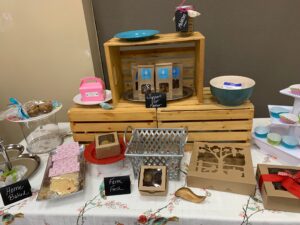
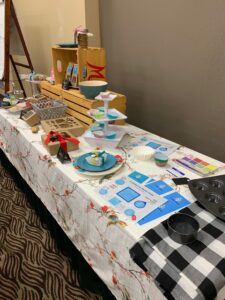
Attendance: 45 women farmers, including 2 agriculture professionals.
5. Launch a Bakery from Your Farm Kitchen: Recipes & Resources: CANCELLED
Date: 3/22/2020
Location: Wegmueller Dairy (Monroe, WI)
Description: We were planning to host a two-hour project overview workshop which would include our entire team along with sampling of tested recipes. Unfortunately, given the COVID-19 outbreak, this workshop needed to be cancelled. While understandable given the turn of world events, it was very disappointing for our team as this was intended to be both the culmination and celebration of all the work everyone contributed to this project. The workshop had already sold out with our maximum space for 20 registrations (interestingly, all women farmers). We were able to follow-up with several of these farmers one-on-one to answer questions and direct them to other resources and consult.
Fortunately, we had already created the online webinar (see below) which provide to be an opportune and ideal alternative to direct the attendees to (minus, of course, sampling!)
B. Online webinar
Lisa Kivirist recorded a one-hour long webinar which was posted on YouTube, giving a project overview and learnings. This webinar proved to be a very strong resource when we needed to cancel our 3/22/20 workshop due to COVID-19 (we had already recorded the webinar and posted and could readily bounce folks there). Having strong photography (see below) contributed to the visual strength of the webinar. As of 3/23/2020, the webinar received 49 views and we expect that to grow.
C. Media & Articles
Our team was able to generate strong media interest in our project. We sent out a final press release Farmstead Baking -SARE Farmer Rancher - Press Release in early March that was sent to a targeted ag media list, which made the Wisconsin Ag Clips on 3/17/20 that went to key agriculture outlets and leaders throughout the state.
The release and sample newsletter blurb was also sent to various agriculture organizations that expressed interest in running something, including the Illinois Stewardship Alliance, Minnesota Farmers Market Association, PASA, MOSES and Farmers Market Pros.
Media highlights include (chronological):
- Milwaukee Journal Sentinel feature article
2/21/18
Home bakers in Wisconsin are happily selling their treats, now that it's legal — you could too
Includes NCR SARE plug.
MJS is the largest circulation publication in Wisconsin with over 153,000 circulation.
- Hobby Farms Feature article
November/December 2019 print issue
Earn Extra With Cottage Food-Approved Baked Goods
Most cottage food laws allow the sale of home-baked goods, so consider launching a bakery business out of your farmstead kitchen.
https://www.hobbyfarms.com/cottage-food-baked-goods/
Includes NCR-SARE plug and quote from Beth Nelson, NCR-SARE Regional Coordinator
- MOSES Organic Broadcaster
March/April issue
New, free toolkit helps farmers launch value-added baking business from home.
Includes NCR-SARE plug/link and quote from Beth Nelson.
- The Country Today
3/14/2020
New resource supports farmers launching home-based bakeries
Includes NCR-SARE plug and quote from Joan Benjamin, NCR-SARE Farmer Rancher Grant Program Coordinator
Monroe Times
3/19/20
Resource to help with recipes available from women farmers
Includes NCR-SARE plug and quote from Joan Benjamin. Note a second/separate article on our project is also scheduled to run in the Monroe Times with recipes.
- Upcoming Media
A second/separate article on our project is also scheduled to run in the Monroe Times with recipes. Additionally, Lisa Kivirist recorded two podcasts that both included a project overview: Thriving Farmer and Forrager.
D. Photography
In August, 2019, John D. Ivanko conducted a photo shoot of our team, both group shots, individual and candid shots along with some recipe product photos. He also did a separate photo shoot with Ashley Wegmueller of each of her farmers market sample displays and various packaging options.
Having a portfolio of high resolution, professional photos significantly helped both our outreach and various elements of this project, including creating a visually engaging webinar and website. We learned it is important to have a selection of both horizontal and vertical high resolution photos so publications like newspapers have various options. Additionally, we were able to offer high quality photo options to the media which were gratefully used by all the media outlets listed above.
Sample photos below.
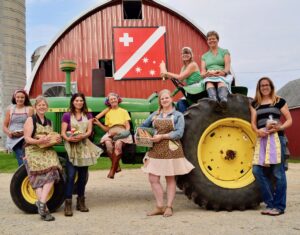
E. Focus groups & sampling
We are fortunate to have a vibrant, on-going “Soil Sisters women in sustainable ag network” in our area that meets regularly for potlucks. Team members brought samples to these gatherings and received feedback at a total of approximately six potlucks over the course of this project.
Estimate 6 new farmers learned about the project/sampled/gave feedback at six events = 36
Learning Outcomes
Lessons Learned:
This project gave us lots of insights:
- Farmers need to think out of the box for income diversification
As we describe this project to farmers, we often hear “I never thought about baked goods being value-added” and then quickly “great idea!” We found there are lots of creative ways to add what you are raising into baked goods, but these are often things farmers don’t think about like adding herbs to bread to truly making it “farmstead artisanal.” The fact that now the baked goods a farmer brings to market contain something from the farm enables a much stronger marketing appeal as truly “farmer produced” and should be something that brings a premium price.
Additionally, we got creative and developed recipes/ideas for baked items a farmer can sell that enhance/increase vegetable sales. For example, we have a recipe for a “farmers market dip” that farmers can give away when folks buy their crackers. The dip recipe uses three cups of chopped vegetables, adding up to increased sales your customer can make at your booth. Likewise, we have a recipe for a quiche crust that you can sell at market in an aluminum pan along with a recipe for quiche that uses your market vegetables, again increasing sales.
- Team focus works to overcome barriers
This project epitomized the strength in bringing together a farmer team as all of this recipe testing and display/packaging development are easy to “divide and conquer” to in the end create a stronger solution. None of us could have alone assembled all of these recipes but together it is achievable.
Having a diverse farmer team also tremendously helped this project. Our farmer team members ranged from 72-year-old LindaDee Derrickson, bringing decades of both farmer expertise as well as running her own restaurant for years, to thirteen-year-old Kalena Riemer, who added fresh new perspectives and recipes, such as a gluten free cheddar biscotti and adding edible flowers to cookies.
- Opportunity to start small
The good news about cottage food baking businesses for farmers is you can start small with practically no cost to get started and test if adding baked goods makes sense for you. By using your home kitchen and with already owning most of the tools/supplies needed for baking, it’s easy to try out an item on a small scale and see if it is right for your market.
- Broader impacts beyond farmer community
While this is a SARE farmer-driven project, these resources we created will be used by home bakers with various non-farmer backgrounds. The majority of cottage food bakers nationally are women in urban and suburban areas running part-time businesses, often stay-at-home moms. With the growth of local and farm-to-table, these recipes will spark ideas among non-farmers to use more locally-produced items in their baked goods and then buy ingredients from their farmer, increasing sales in a different way.
• Women farmer driven
The interest in launching a value-added baking business definitely skews female, which reflects the research conducted by the Institute for Justice of all home baking entrepreneurs in Wisconsin where over 75% of these bakers were women. With this in mind, we designed our website and materials accordingly in design and got feedback from women farmers along the way.
• Learning to navigate unexpected detours
COVID-19 hit fast and furious just as we were wrapping up this project and doing the outreach, including the need to cancel our final 3/22/20 workshop. This was very disappointing for our team, but one we're all simply learning to live with. While we received strong media attention to our press release the first two weeks in March, interest undoubtedly watered down as COVID-19's impact grew. The fact that the COVID-19's impending impact on canceling spring farmer's market season also diluted immediate interest in our project. Bottom line, adding a new bakery component was probably least on a farmer's mind when this project went live -- even though we timed the release for March when typically everyone is super interested and open to new ideas for the market season. Hence, we learn to adapt. The good news is that once COVID-19's impact subsides and hopefully lives will return to a new normal, communities will value even more their local farmers and be looking for more then ever these kinds of locally-made bakery products, and we'll be there ready to help with zucchini muffins, beet brownies and more!
Note: The 100 farmers reporting changes in Knowledge, Attitudes, Skills, and Awareness (KASA) is based on approximately half of the farmers who attended our workshops. Response to these sessions was very positive and attendees found our information along with the ability to consult and brainstorm one-on-one very helpful.
Project Outcomes
Note the 25 farmers/ranchers who adopted a practice (i.e., started a farm bakery) is an estimate given the over 200 people we connected with via the workshops along with the media outreach and website hits. This number may unfortunately be stagnant for the duration of COVID-19 given the unprecedented situation of farmer's markets generally closing for the undetermined future. We are hopeful that this will eventually pass, at which point our resources will be ready to go to support farmers.
From a Wisconsin farmer:
"I found the resources in this project super helpful. The information on water activity particularly useful - how to decrease moisture when incorporating fresh produce, safe frosting recipes, etc. Also, having done all the supply sourcing before launching the candle business, I know how much time it can take to search out, investigate, and compare prices for equipment & packaging, so the table of suppliers is a fantastic resource. It also led me to at least one company I had found years ago, but whose website I had not visited in a long time - with happy findings! Thank you."
On behalf of our farmer team, we really appreciate NCR SARE's support on this project. We realize the idea of value-added baked goods may have been a little "out of the box" of expected submissions and appreciate SARE's commitment to innovation and thinking outside of the box on new ways and opportunities to diversify farm income.
Everyone on the NCR SARE staff was so helpful and quickly responded to our questions and helped us navigate together any issues as they come up. Our final main project workshop and outreach came on just as COVID-19 was ramping up and we very much appreciate NCR SARE prioritizing everyone's safety and being so supportive and understanding when we needed to cancel our 3/22/20 workshop.
The online reporting format was very easy to use and gave us ample opportunity to elaborate and add details and visuals.
